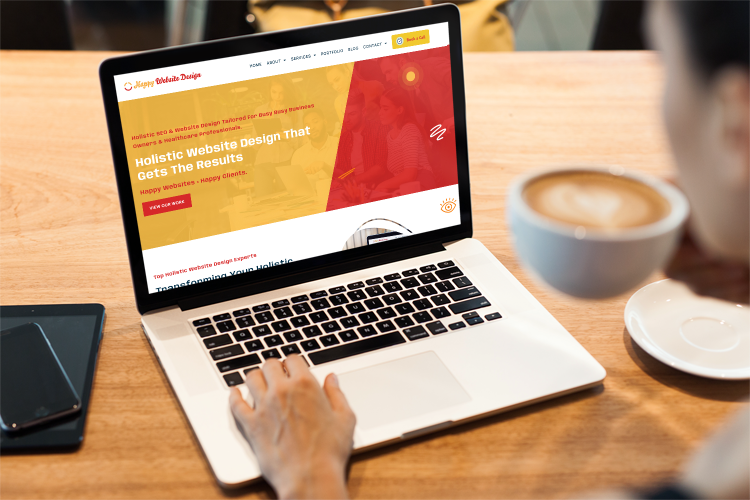Why Holistic Web Design Is the Secret to a Smooth Customer Experience
In today's electronic landscape, the relevance of holistic internet style can not be overstated, as it delicately weaves together visual appeals, use, and performance to produce a seamless customer experience. By adopting a detailed approach that prioritizes customer needs and leverages comments, designers can improve the total communication with their platforms.
Recognizing Holistic Internet Design

Integrating individual comments and behavioral information is essential in all natural website design. This iterative procedure assists designers to determine discomfort points and areas for improvement, making sure that the end product resonates with customers. All natural style emphasizes the value of ease of access, guaranteeing that all users, no matter of their abilities, can browse and communicate with the internet site properly.
In addition, the integration of receptive design principles is essential in suiting different tools and screen dimensions, further improving the user experience. By comprehending the interconnectedness of these parts, designers can produce internet sites that not just attract however also keep individuals, ultimately driving involvement and conversions. Holistic internet layout is, therefore, a calculated approach that fosters a purposeful partnership between individuals and electronic areas, leading the way for lasting on-line success.
Key Elements of Holistic Design

Another crucial component is uniformity in visual and functional elements across the internet site. This includes maintaining a natural color scheme, typography, and design, which aids individuals navigate the website without effort - happy web design. In addition, responsive layout is necessary, making sure that the site performs efficiently throughout various tools and display dimensions
Accessibility is additionally a vital element of holistic style. By sticking to access criteria, designers can produce comprehensive experiences that satisfy varied user teams, consisting of those with impairments. The integration of content method makes certain that valuable information is provided clearly and succinctly, boosting understanding and engagement.
Last but not least, effective partnership amongst layout, growth, and marketing groups promotes a unified vision that lines up with service objectives. By focusing on these crucial elements, holistic website design can provide an enriching user experience that is both interesting and useful.
Advantages of a Smooth Experience
Developing a seamless customer experience uses countless advantages that significantly enhance overall satisfaction and interaction. At its core, a seamless experience fosters a sense of ease and intuition, allowing users to navigate a site or application effortlessly. This reduction in friction not only boosts the probability of users returning but additionally boosts their readiness to suggest the platform to others.
Furthermore, a seamless experience leads to boosted conversion prices. When individuals find what they need with minimal effort, they are more likely to complete desired activities, such as purchasing or authorizing up for an e-newsletter. This effectiveness translates right into greater customer retention, as pleased users are extra most likely to become dedicated advocates for the brand name.
Additionally, a natural and smooth interface reduces cognitive tons, enabling users to concentrate on material rather than fighting with navigating or style variances. This clarity not just enhances individual fulfillment yet additionally reinforces brand name reliability. Ultimately, prioritizing a seamless individual experience results in an affordable advantage, as companies that invest in this element are much better placed to fulfill the advancing expectations of their target market and drive lasting success.
Executing All Natural Approaches
To accomplish a genuinely smooth user experience, companies must adopt all natural strategies that think about every facet of design and performance. This strategy begins with a linked vision that aligns team members throughout numerous self-controls, including UX/UI layout, content advancement, and technological execution. Efficient collaboration fosters a shared understanding of individual requirements and purposes, permitting more meaningful style options.
Following, it is crucial to their explanation produce individual identities and journey maps that reflect the diverse demographics and behaviors of the target audience. By feeling sorry for customers' viewpoints, companies these details can prepare for obstacles and simplify communications throughout the digital experience.

Furthermore, constant branding and messaging must permeate every touchpoint, making sure a well-known and reliable visibility that improves individual engagement. Integrating receptive layout concepts is likewise important, as users now interact with content throughout numerous gadgets.
Additionally, organizations need to prioritize ease of access, ensuring that all customers, despite ability, can browse and gain from their electronic offerings. By installing these all natural techniques right into the design procedure, companies can produce a cohesive and pleasurable user experience that advertises complete satisfaction and commitment.
Measuring User Experience Success
While attaining a holistic method to website design is vital, measuring customer experience success is equally crucial to make certain that layout strategies efficiently meet user demands. This calls for a combination of qualitative and measurable metrics to get an extensive understanding of individual communications and complete satisfaction levels.
Secret performance signs (KPIs) such as user engagement, conversion rates, and bounce prices supply beneficial measurable insights. A high conversion rate may indicate that customers find the style instinctive and engaging. Alternatively, raised bounce rates can signify that individuals are dissatisfied or confused, demanding a reevaluation of the design components.
Qualitative steps, consisting of individual comments, surveys, and use testing, are important for obtaining deeper understandings right into the customer experience. Analyzing user comments can reveal pain factors and locations for improvement, while usability examinations permit designers to observe real-time interactions and determine challenges individuals deal with.
Ultimately, the assimilation of these dimension methods allows for continuous refinement of web style, ensuring it remains user-centered and effective in providing a smooth experience (happy web design). On a regular basis Learn More Here reviewing these metrics will certainly make it possible for designers to adapt to developing individual demands and preferences, strengthening the general success of an all natural website design method
Final Thought
To conclude, holistic website design arises as a fundamental approach to accomplishing a smooth customer experience. By integrating aesthetic appeals, functionality, and use, this design viewpoint addresses varied customer requirements and choices. The concentrate on user-centered strategies not just boosts navigation and complete satisfaction but also promotes brand name reputation and access. Inevitably, the application of holistic layout principles considerably contributes to enhanced conversion prices and consumer retention, establishing a robust framework for efficient electronic communications.